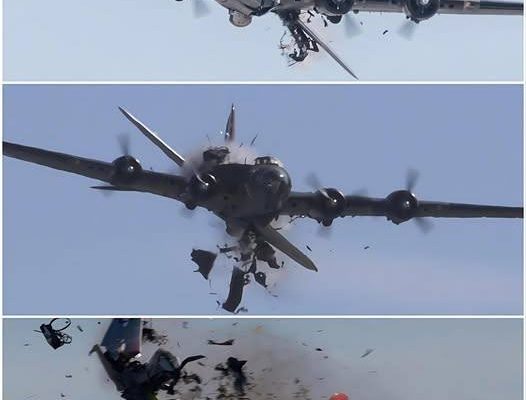Tragically, the celebration turned into catastrophe when a mid-air collision occurred between two historic aircraft during a scheduled demonstration flight. The aircraft involved were a Boeing B-17 Flying Fortress, a four-engine heavy bomber that was instrumental in the Allied bombing campaigns during World War II, and a Bell P-63 Kingcobra, a rare American fighter aircraft designed in the 1940s, known for its unique design and role in military aviation history.
As spectators watched in awe of the airborne choreography, the two planes collided in a sudden and violent moment that shocked the crowd…
The global aviation community was struck with deep sorrow following a tragic incident that occurred during a commemorative airshow in Dallas, Texas, in November 2022. The event, called Wings Over Dallas, was hosted by the Commemorative Air Force and was meant to honor and remember the rich history of aviation, particularly the heroic efforts and sacrifices made during World War II. Thousands of attendees, including families, veterans, aviation historians, and enthusiasts, had gathered to witness vintage aircraft in flight—planes that once played pivotal roles in shaping the course of history.
Tragically, the celebration turned into catastrophe when a mid-air collision occurred between two historic aircraft during a scheduled demonstration flight. The aircraft involved were a Boeing B-17 Flying Fortress, a four-engine heavy bomber that was instrumental in the Allied bombing campaigns during World War II, and a Bell P-63 Kingcobra, a rare American fighter aircraft designed in the 1940s, known for its unique design and role in military aviation history.
As spectators watched in awe of the airborne choreography, the two planes collided in a sudden and violent moment that shocked the crowd and the wider world. The B-17, known for its durability and strength during wartime missions, was being flown by a dedicated crew of experienced volunteers. The P-63, which had been flying in close proximity as part of the air display, struck the B-17 from behind during a maneuver. Within seconds, both aircraft were destroyed mid-air, and fiery debris fell to the ground. Sadly, all six crew members aboard the two planes lost their lives in the accident. No injuries were reported among spectators on the ground.
Eyewitnesses described the scene as horrific and unforgettable. Many people initially thought it was part of the show, only to realize moments later that a real disaster had unfolded in front of them. Families, children, veterans, and aviation fans stood in disbelief, many in tears, as emergency crews rushed to the scene. The incident immediately drew widespread media coverage and expressions of grief from around the world.
The tragedy sparked renewed discussions about the safety of operating and displaying vintage military aircraft, especially during public events. These aircraft, while mechanically restored and maintained to high standards, are often over 75 years old and present unique operational challenges. Experts acknowledged the inherent risk involved in flying historic warbirds, but also emphasized the importance of stringent safety protocols, airshow planning, and pilot coordination to minimize such dangers.
The National Transportation Safety Board (NTSB) and the Federal Aviation Administration (FAA) quickly launched an investigation to determine the causes and contributing factors of the collision. This included a review of flight paths, pilot experience, airshow procedures, and communication protocols. The findings would later be used to improve guidelines for future air displays and to help prevent similar tragedies from occurring again.
Despite the sorrow and the shock, many within the aviation community and beyond emphasized the continued importance of preserving and honoring aviation history. Airshows like Wings Over Dallas are not only entertainment events—they serve as living history lessons, offering the public a chance to witness the engineering marvels of the past and learn about the courageous individuals who built, maintained, and flew them.
Historians, pilots, and aviation advocates agree that these vintage aircraft are more than just machines—they are symbols of a generation that endured one of the most challenging periods in modern history. By keeping them flying, organizations aim to educate younger generations and keep the memory of wartime service alive.
Yet, the tragedy serves as a powerful and painful reminder: while we seek to remember the past, we must always prioritize safety in the present. The loss of the skilled and passionate crew members at Wings Over Dallas in 2022 was not only a devastating moment for their families and friends but also for the broader community that values aviation heritage.
In the wake of the accident, the airshow community has taken a hard look at how these events are organized, with a renewed focus on pilot training, communication protocols, airspace separation, and overall risk management. The goal is clear—to ensure that future generations can continue to honor the past without putting lives unnecessarily at risk.
As communities across the country and the world continue to celebrate the legacy of aviation, the Wings Over Dallas tragedy remains a somber chapter—a moment of profound loss that carries with it an urgent message about the balance between commemoration and caution. The skies may hold the stories of history, but how we choose to tell those stories must always place human life at the center.



